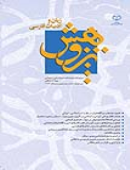خماری زاهد یا خوشخویی دُردکشان؛ بررسي و تحليل بيتي بحث برانگيز از حافظ
محورهای موضوعی : پژوهشهای ادبیات کلاسیک ایران
خدیجه حاجیان
1
*
,
سعید بزرگ بیگدلی
2
![]()
1 -
2 -
کلید واژه: عبوس زهد وجه خمار خرقه دُردیکشان حافظ,
چکیده مقاله :
برخلاف بسیاری از شاعران ادب فارسی به ویژه مشهورترین آنان، شناخت اندیشه و جهانبینی حافظ عمدتاً منوط به اشعار اوست که بخش اصلی آن غزلیات است. شرح تک بیتهایی از غزليات حافظ سابقة دیرین دارد و در سالهای اخیر سرماية تحریر مقالههای فراوانی شده است. در این مقالهها به شرح تفسیري، یا تأویلی تمام بیت پرداخته شده، یا درباره کلمات و نکاتی از بیت اظهار نظر و بحث شده یا در درستی و اصالت صورت ضبط شده بعضی از مفردات و ترکیبهای آنها تردیده شده است که بیشتر از نوع شرح و تاویل بیت است. یکی از ابیات «بحثبرانگیز» که تاکنون بیشترین شرح و اظهارنظر دربارة آن انجام گرفته، این بیت است: عبوس زهد به وجه خمار ننشیند مرید خرقة دردیکشان خوشخویم بخش مهمی از شرح و تفسیرهای دربارة این بیت، پس از انتشار تصحيح حافظ به دست مرحوم خانلری نوشته شده است. وی برخلاف تمام نسخههای پیشین، در مصرع اول، فعل «بنشیند» را بر «ننشیند» ترجیح داده و همین نکته بحثهای فراوانی را در شرح بیت، برانگیخته است. در این مقاله با مراجعه به آرا و نظریات نویسندگان و شارحان دربارة بیت، این نظریات، بررسی، مقایسه و تحلیل شده است. با توجه به بررسی و تحلیل این نظریات در مجموع میتوان نتیجه گرفت که حافظ در این بیت میان «عبوسی» و گرفتگی ناشی از زهد (که در چهرة زاهد نمودار است) با گرفتگی و عبوسی ناشی از میزدگی و خماری دردنوشان مقایسهای کرده، این را بر آن ترجیح مینهد و در تایید و تأکید این رجحان در مصرع دوم خود را مرید خرقه دُردیکشان خوشخو میخواند.
Unlike many of Persian poets, especially the most well-known poets, the recognition of thought and world view of Hafez relies on his poetry to a large extent; mainly consisting of sonnets. An Interpretation of some of Hafez’ couplets has been done since a long time ago. During recent years, this issue has however led to a large number of writings. Such articles focus on the interpretative explanation or the paraphrase of the whole couplet, or in other cases opinions have been offered about some of the words; making some points elaborately clear. Following this, the appropriateness and the origin of the recorded form of some of these verses and their combinations are questioned; tending furthermore towards explanation paraphrase. One of the most ‘controversial’ verses which has enjoyed the most interpretations and comments so far is; Aboos e Zohd be Vajhe Khomar Nanshinad Morid e Khergheye Dordikeshan e Khoshkhoyam The major part of these interpretations and explanations on this couplet were written after Khanlari published his version of Hafez’ poetry book (known as Divan). Unlike all the other existing copies of Hafez’ Poetry book, he has preferred the verb “sit” instead of “refused to sit”; which has led to serious discussions within the explanation of this couplet. This article surveys, analyzes and compares these opinions and views through referring to the views and insights of the writers and experts who have interpreted this couplet line. Regarding the survey and analysis of these opinions, it can be concluded that in this couplet Hafez has compared the “sulkiness” drawn from piousness (which is apparent in the face of the pious person), with the tenseness and sulkiness drawn from drunkenness and the languor of the beloved one (Dordkeshan); while he prefers the later one and for emphasizing it, he calls himself the disciple of the friendly mannered beloved (khergheye- Dordikeshan- khoshkho).

